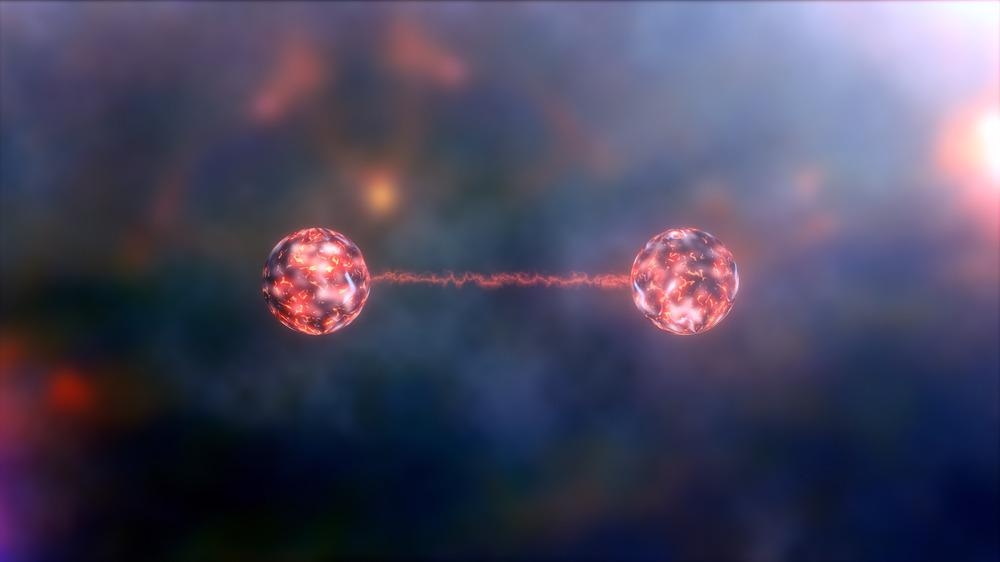Quantum entanglement is a fascinating physical phenomenon that sees two particles share what can be understood as a type of connection or communication, whereby any actions performed on one particle will also affect the other(s), irrespective of their distance apart. This is further explored in the journal Physics Review B.

Study: Witnessing entanglement in quantum magnets using neutron scattering. Image Credit: ezphoto/Shutterstock.com
Albert Einstein famously referred to this phenomenon as “spooky action at a distance.”
One of the key challenges in understanding and characterizing quantum entanglement lies in being able to observe and record these in a tangible way. In the 1960s, John Stewart Bell introduced the concept of ‘entanglement witnesses’ – a technique that allowed quantum entanglement to be observed and proven to be correct by detecting one pair of particles at a time.
New research presented in the Physical Review B journal aims to expand upon Bell’s technique, allowing the potential study of solid materials that are frequently comprised of trillions of particles.
The research was focused on further demonstrating the viability of the quantum entanglement witness concept and its ability to prove entanglement exists between magnetic particles - or spins - in a quantum material.
Used in this way, entanglement witnesses offer useful data analysis tools for determining which of these spins cross the threshold into the quantum realm.
Research into quantum entanglement of complex materials could lead to new applications and the development of new states of matter with beneficial properties – factors which have seen this phenomenon gain renewed interest in recent years.
Three of these entanglement witnesses were tested using an advanced combination of neutron scattering experiments and computational simulations.
The researchers extended this concept to investigate a range of solid materials and to explore a number of exotic behaviors in quantum magnets and superconductors.
They achieved this by targeting and detecting collections of entangled spins via three new entanglement witnesses – two based on Bell’s approach and a third based on quantum information theory.
In order to evaluate the effectiveness of these entanglement witnesses, the researchers applied each one to a material that a previous study had confirmed as being entangled. This material involved a line of adjacent spins that disregard other particles, instead of communicating with their neighbors.
The witnesses based on Bell’s approach confirmed the existence of entanglement in the material to an adequate degree, while the witness based on quantum information theory was found to perform extremely well.
A notable challenge when studying quantum entanglement stems from the chance that fluctuations in a material caused by random thermal motion could appear to be a result of quantum effects.
The only way to mitigate this risk and remove the chance of false-positive results is to conduct investigations at absolute zero – a practical and economical challenge that makes these experiments difficult.
Using their approach, the researchers were able to confirm the previously theorized notion that entanglement increases as temperature decreases. The research was also able to confidently differentiate between classical and quantum activity.
In order to further validate their approach, a second spin chain was tested – this time featuring a more complex material with more complicated spin properties.
Neutrons represent a highly useful tool for investigating a material’s properties due to their non-destructive nature and neutral charge. Each of the evaluated spin chains was therefore investigated using neutron scattering and compared against an analysis of both legacy and more recent data from published experiments.
The additional use of complementary simulations also helped validate these findings.
With these new quantum entanglement witnesses identified and characterized, future research can begin on the characterization of new entanglement witnesses.
It is anticipated that the investigation of more complex entanglement witnesses will necessitate the use of high-resolution techniques and advanced scattering experiments. Inelastic x-ray scattering and THz spectroscopy may also offer other useful means of studying this phenomenon.
This more streamlined process also opens up new pathways to leveraging the power of quantum spin liquids and superconductors for data storage and computing applications.
Ultimately, it is anticipated that these new models and experimental approaches could support the characterization of even the most complex and historically puzzling quantum materials.
The researchers believe that their approach to the characterization of entanglement witnesses using advanced computational and experimental approaches offers answers to questions originally asked by the founders of the field of quantum mechanics.
They also predict that the calculations used in their approach are likely to become part of the standard procedure for neutron scattering experiments, potentially transforming this methodology and field.
Disclaimer: The views expressed here are those of the author expressed in their private capacity and do not necessarily represent the views of AZoM.com Limited T/A AZoNetwork the owner and operator of this website. This disclaimer forms part of the Terms and conditions of use of this website.
Sources:
A Scheie, Pontus Laurell, A. M. Samarakoon, B. Lake, S. E. Nagler, G. E. Granroth, S. Okamoto, G. Alvarez, and D. A. Tennant. (2021). Witnessing entanglement in quantum magnets using neutron scatteringPhys. Rev. B 103, 224434 – Published 28 June 2021 https://journals.aps.org/prb/abstract/10.1103/PhysRevB.103.224434
Oak Ridge National Laboratory 2021 Key witness helps scientists detect ‘spooky’ quantum entanglement in solid materials https://www.ornl.gov/news/key-witness-helps-scientists-detect-spooky-quantum-entanglement-solid-materials